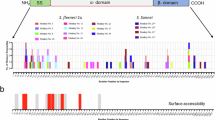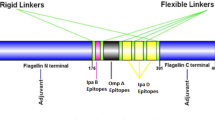Abstract
Background:
Children with sickle cell disease (SCD) are susceptible to recurrent infections, which are often life threatening and necessitate frequent vaccinations. Given the altered baseline immunity and proinflammatory state associated with SCD, we sought to determine the relative safety and efficacy of vaccination in transgenic SCD mice.
Methods:
Eight-week-old SCD mice were vaccinated with ovalbumin and aluminum hydroxide weekly for 3 wk by the intraperitoneal or intramuscular route. One week after the third vaccination, serum cytokines/chemokines, immunoglobulins, and bronchoalveolar lavage fluid cytokines were measured.
Results:
Only SCD mice were prone to mortality associated with vaccination, as 40% of the animals died after the intraperitoneal vaccinations and 50% died after the intramuscular vaccinations. Serum IgG2b and IgM were significantly lower in SCD mice than in C57BL/6 mice after vaccination, but ovalbumin-specific IgE was significantly higher. Serum interleukin (IL)-1α, IL-2, IL-5, macrophage inflammatory protein 1α, and granulocyte macrophage-colony stimulating factor were significantly lower in SCD mice than in C57BL/6 mice after vaccination, whereas bronchoalveolar lavage fluid IL-1β and IL-6 were increased.
Conclusion:
Mice with SCD appear to have a dysregulated immune response to vaccination. Thus, the relative safety and immunogenicity of vaccination should be studied in greater detail in the context of SCD.
Similar content being viewed by others
Log in or create a free account to read this content
Gain free access to this article, as well as selected content from this journal and more on nature.com
or
References
Overturf GD . Infections and immunizations of children with sickle cell disease. Adv Pediatr Infect Dis 1999;14:191–218.
Adamkiewicz TV, Sarnaik S, Buchanan GR, et al. Invasive pneumococcal infections in children with sickle cell disease in the era of penicillin prophylaxis, antibiotic resistance, and 23-valent pneumococcal polysaccharide vaccination. J Pediatr 2003;143:438–44.
Halasa NB, Shankar SM, Talbot TR, et al. Incidence of invasive pneumococcal disease among individuals with sickle cell disease before and after the introduction of the pneumococcal conjugate vaccine. Clin Infect Dis 2007;44:1428–33.
McCavit TL, Quinn CT, Techasaensiri C, Rogers ZR . Increase in invasive Streptococcus pneumoniae infections in children with sickle cell disease since pneumococcal conjugate vaccine licensure. J Pediatr 2011;158:505–7.
Bjornson AB, Lobel JS . Direct evidence that decreased serum opsonization of Streptococcus pneumoniae via the alternative complement pathway in sickle cell disease is related to antibody deficiency. J Clin Invest 1987;79:388–98.
Ballester OF, Abdallah JM, Prasad AS . Impaired IgM antibody responses to an influenza virus vaccine in adults with sickle cell anemia. Am J Hematol 1985;20:409–12.
Rautonen N, Martin NL, Rautonen J, Rooks Y, Mentzer WC, Wara DW . Low number of antibody producing cells in patients with sickle cell anemia. Immunol Lett 1992;34:207–11.
Szczepanek SM, McNamara JT, Secor ER Jr, et al. Splenic morphological changes are accompanied by altered baseline immunity in a mouse model of sickle-cell disease. Am J Pathol 2012;181:1725–34.
Purohit S, Alvarez O, O’Brien R, Andreansky S . Durable immune response to inactivated H1N1 vaccine is less likely in children with sickle cell anemia receiving chronic transfusions. Pediatr Blood Cancer 2012;59:1280–3.
Hambidge SJ, Ross C, McClure D, Glanz J ; VSD team. Trivalent inactivated influenza vaccine is not associated with sickle cell hospitalizations in adults from a large cohort. Vaccine 2011;29:8179–81.
Hambidge SJ, Ross C, Glanz J, et al.; Vaccine Safety Datalink Team. Trivalent inactivated influenza vaccine is not associated with sickle cell crises in children. Pediatrics 2012;129:e54–9.
Hambidge SJ, Glanz JM, France EK, et al.; Vaccine Safety Datalink Team. Safety of trivalent inactivated influenza vaccine in children 6 to 23 months old. JAMA 2006;296:1990–7.
Wallace KL, Marshall MA, Ramos SI, et al. NKT cells mediate pulmonary inflammation and dysfunction in murine sickle cell disease through production of IFN-gamma and CXCR3 chemokines. Blood 2009;114:667–76.
Holtzclaw JD, Jack D, Aguayo SM, Eckman JR, Roman J, Hsu LL . Enhanced pulmonary and systemic response to endotoxin in transgenic sickle mice. Am J Respir Crit Care Med 2004;169:687–95.
Nandedkar SD, Feroah TR, Hutchins W, et al. Histopathology of experimentally induced asthma in a murine model of sickle cell disease. Blood 2008;112:2529–38.
Pritchard KA Jr, Feroah TR, Nandedkar SD, et al. Effects of experimental asthma on inflammation and lung mechanics in sickle cell mice. Am J Respir Cell Mol Biol 2012;46:389–96.
Secor ER, Carson WF, Singh A, et al. Oral bromelain attenuates inflammation in an ovalbumin-induced murine model of asthma. Evid Based Complement Alternat Med 2008;5:61–9.
Unkeless JC, Scigliano E, Freedman VH . Structure and function of human and murine receptors for IgG. Annu Rev Immunol 1988;6:251–81.
Hord J, Windsor B, Koehler M, Blatt J, Janosky J, Mirro J . Diminished antibody response to hepatitis B immunization in children with sickle cell disease. J Pediatr Hematol Oncol 2002;24:548–9.
Narni-Mancinelli E, Campisi L, Bassand D, et al. Memory CD8+ T cells mediate antibacterial immunity via CCL3 activation of TNF/ROI+ phagocytes. J Exp Med 2007;204:2075–87.
Wanjalla CN, Goldstein EF, Wirblich C, Schnell MJ . A role for granulocyte-macrophage colony-stimulating factor in the regulation of CD8+ T cell responses to rabies virus. Virology 2012;426:120–33.
He S, Cao Q, Yoneyama H, Ge H, Zhang Y, Zhang Y . MIP-3α and MIP-1α rapidly mobilize dendritic cell precursors into the peripheral blood. J Leukoc Biol 2008;84:1549–56.
Dawson TC, Beck MA, Kuziel WA, Henderson F, Maeda N . Contrasting effects of CCR5 and CCR2 deficiency in the pulmonary inflammatory response to influenza A virus. Am J Pathol 2000;156:1951–9.
Chies JA, Hutz MH . High frequency of the CCR5Δ32 variant among individuals from an admixed Brazilian population with sickle cell anemia. Braz J Med Biol Res 2003;36:71–5.
Moffitt KL, Gierahn TM, Lu YJ, et al. TH17-based vaccine design for prevention of Streptococcus pneumoniae colonization. Cell Host Microbe 2011;9:158–65.
Miller ML, Gao G, Pestina T, Persons D, Tuomanen E . Hypersusceptibility to invasive pneumococcal infection in experimental sickle cell disease involves platelet-activating factor receptor. J Infect Dis 2007;195:581–4.
Jonker MA, Hermsen JL, Gomez FE, Sano Y, Kudsk KA . Injury induces localized airway increases in pro-inflammatory cytokines in humans and mice. Surg Infect (Larchmt) 2011;12:49–56.
Wanderer AA . Rationale for IL-1β targeted therapy for ischemia-reperfusion induced pulmonary and other complications in sickle cell disease. J Pediatr Hematol Oncol 2009;31:537–8.
Kabbur PM, Carson WF 4th, Guernsey L, Secor ER Jr, Thrall RS, Schramm CM . Interleukin-10 does not mediate inhalational tolerance in a chronic model of ovalbumin-induced allergic airway disease. Cell Immunol 2006;239:67–74.
Author information
Authors and Affiliations
Corresponding author
Rights and permissions
About this article
Cite this article
Szczepanek, S., Secor, E., Bracken, S. et al. Transgenic sickle cell disease mice have high mortality and dysregulated immune responses after vaccination. Pediatr Res 74, 141–147 (2013). https://doi.org/10.1038/pr.2013.85
Received:
Accepted:
Published:
Issue date:
DOI: https://doi.org/10.1038/pr.2013.85



